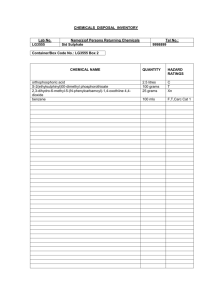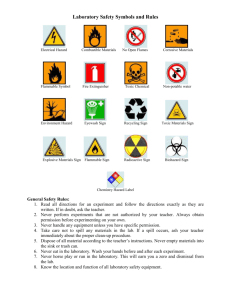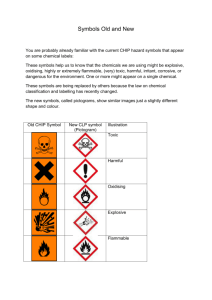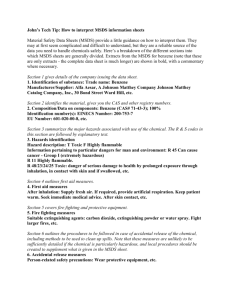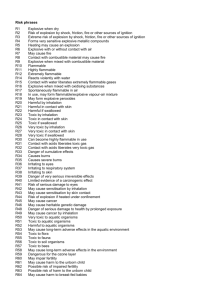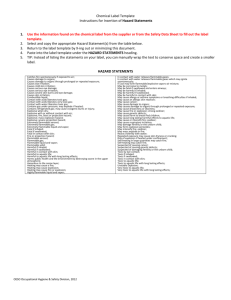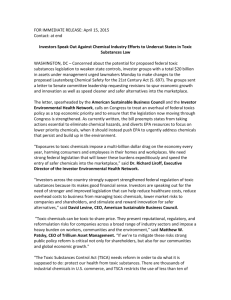MSDS of classification and labelling of Chemicals
advertisement
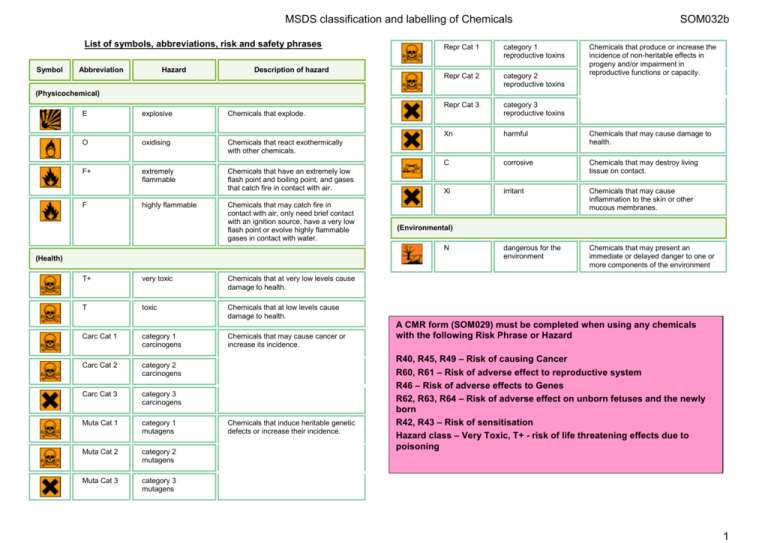
MSDS classification and labelling of Chemicals List of symbols, abbreviations, risk and safety phrases Symbol Abbreviation Hazard Description of hazard SOM032b Repr Cat 1 category 1 reproductive toxins Chemicals that produce or increase the incidence of non-heritable effects in progeny and/or impairment in reproductive functions or capacity. Repr Cat 2 category 2 reproductive toxins Repr Cat 3 category 3 reproductive toxins Xn harmful Chemicals that may cause damage to health. C corrosive Chemicals that may destroy living tissue on contact. Xi irritant Chemicals that may cause inflammation to the skin or other mucous membranes. dangerous for the environment Chemicals that may present an immediate or delayed danger to one or more components of the environment (Physicochemical) E explosive Chemicals that explode. O oxidising Chemicals that react exothermically with other chemicals. F+ extremely flammable Chemicals that have an extremely low flash point and boiling point, and gases that catch fire in contact with air. F highly flammable Chemicals that may catch fire in contact with air, only need brief contact with an ignition source, have a very low flash point or evolve highly flammable gases in contact with water. (Environmental) N (Health) T+ very toxic Chemicals that at very low levels cause damage to health. T toxic Chemicals that at low levels cause damage to health. Carc Cat 1 category 1 carcinogens Chemicals that may cause cancer or increase its incidence. Carc Cat 2 category 2 carcinogens Carc Cat 3 category 3 carcinogens Muta Cat 1 category 1 mutagens Muta Cat 2 category 2 mutagens Muta Cat 3 category 3 mutagens Chemicals that induce heritable genetic defects or increase their incidence. A CMR form (SOM029) must be completed when using any chemicals with the following Risk Phrase or Hazard R40, R45, R49 – Risk of causing Cancer R60, R61 – Risk of adverse effect to reproductive system R46 – Risk of adverse effects to Genes R62, R63, R64 – Risk of adverse effect on unborn fetuses and the newly born R42, R43 – Risk of sensitisation Hazard class – Very Toxic, T+ - risk of life threatening effects due to poisoning 1 MSDS classification and labelling of Chemicals SAFETY PHRASES SOM032b by the manufacturer) S1 S Keep locked up S41 A In case of fire and/or explosion do not breathe fumes S2 S Keep out of the reach of children S42 S3 S Keep in a cool place P During fumigation/spraying wear suitable respiratory equipment (appropriate wording to be specified by the manufacturer) S4 S Keep away from living quarters S43 S5 S Keep contents under ... (appropriate liquid to be specified by the manufacturer) A In case of fire use ... (indicate in the space the precise type of fire-fighting equipment. If water increases the risk add - Never use water) S6 S Keep under ... (inert gas to be specified by the manufacturer) S45 S7 S Keep container tightly closed A In case of accident or if you feel unwell seek medical advice immediately (show the label where possible) S8 S Keep container dry S46 F If swallowed, seek medical advice immediately and show this container or label S9 S Keep container in a well-ventilated place S47 U Keep at temperature not exceeding ... OC (to be specified by the manufacturer) S12 S Do not keep the container sealed S48 U Keep wet with ... (appropriate material to be specified by the manufacturer) S Keep away from food, drink and animal feeding stuffs S49 U Keep only in the original container S14 S Keep away from ... (incompatible materials to be indicated by the manufacturer) S50 U Do not mix with ... (to be specified by the manufacturer) S15 S Keep away from heat S51 U Use only in well-ventilated areas S16 S Keep away from sources of ignition - No smoking S52 U Not recommended for interior use on large surface areas S17 S Keep away from combustible material S53 U Avoid exposure - obtain special instructions before use S56 D Dispose of this material and its container at hazardous or special waste collection point S57 D Use appropriate containment to avoid environmental contamination S59 D Refer to manufacturer/supplier for information on recovery/recycling S60 D This material and its container must be disposed of as hazardous waste S61 D Avoid release to the environment. Refer to special instructions/safety data sheet S62 F If swallowed, do not induce vomiting: seek medical advice immediately and show this container or label S13 S18 U Handle and open container with care S20 U When using do not eat or drink S21 U When using do not smoke S22 S23 U Do not breathe dust S U P F D A - Storage - Usage - Protection - First aid - Disposal - Accident U Do not breathe gas/fumes/vapour/spray (appropriate wording to be specified by the manufacturer) S24 P Avoid contact with skin S25 P Avoid contact with eyes S63 A In case of accident by inhalation: remove casualty to fresh air and keep at rest S26 F In case of contact with eyes, rinse immediately with plenty of water and seek medical advice S64 F If swallowed, rinse mouth with water (only if the person is conscious) S27 F Take off immediately all contaminated clothing S28 F After contact with skin, wash immediately with plenty of ... (to be specified by the manufacturer) S29 D Do not empty into drains S30 U Never add water to this product S33 U Take precautionary measures against static discharges S35 D This material and its container must be disposed of in a safe way S36 P Wear suitable protective clothing S37 P Wear suitable gloves S38 P In case of insufficient ventilation wear suitable respiratory equipment S39 P Wear eye/face protection S40 A To clean the floor and all objects contaminated by this material use ... (to be specified S U P F D A - Storage - Usage - Protection - First aid - Disposal - Accident 2 MSDS classification and labelling of Chemicals RISK PHRASES SOM032b R40 H Limited evidence of a carcinogenic effect R1 PC Explosive when dry R41 H Risk of serious damage to eyes R2 PC Risk of explosion by shock, friction, fire or other sources of ignition R42 V May cause sensitisation by inhalation R3 PC Extreme risk of explosion by shock, friction, fire or other sources of ignition R43 V May cause sensitisation by skin contact R4 PC Forms very sensitive explosive metallic compounds R44 R5 PC Heating may cause an explosion R45 V May cause cancer R6 PC Explosive with or without contact with air R46 H May cause heritable genetic damage R7 PC May cause fire R48 V Danger of serious damage to health by prolonged exposure R8 PC Contact with combustible material may cause fire R49 V May cause cancer by inhalation R9 PC Explosive when mixed with combustible material R50 E Very toxic to aquatic organisms R10 PC Flammable R51 E Toxic to aquatic organisms R11 PC Highly flammable R52 E Harmful to aquatic organisms R12 PC Extremely flammable R53 E May cause long-term adverse effects in the aquatic environment R14 PC Reacts violently with water R54 E Toxic to flora R15 PC Contact with water liberates extremely flammable gases R55 E Toxic to fauna R16 PC Explosive when mixed with oxidising substances R56 E Toxic to soil organisms R17 PC Spontaneously flammable in air R57 E Toxic to bees R18 PC In use, may form flammable/explosive vapour-air mixture R58 E May cause long-term adverse effects in the environment R19 PC May form explosive peroxides R59 E Dangerous for the ozone layer R20 M Harmful by inhalation R60 H May impair fertility R21 M Harmful in contact with skin R61 H May cause harm to the unborn child R22 M Harmful if swallowed R62 M Possible risk of impaired fertility R23 H Toxic by inhalation R63 M Possible risk of harm to the unborn child R24 H Toxic in contact with skin R25 H Toxic if swallowed R26 V Very toxic by inhalation R27 V Very toxic in contact with skin R28 V Very toxic if swallowed R30 PC Can become highly flammable in use R31 H Contact with acids liberates toxic gas R32 V Contact with acids liberates very toxic gas R33 V Danger of cumulative effects R34 H Causes burns R35 V Causes severe burns R36 M Irritating to eyes R37 M Irritating to respiratory system R38 M Irritating to skin R39 V Danger of very serious irreversible effects PC M H V E - Physical & Chemical - Medium Risk - High Risk - Very High Risk - Environmental Risk PC Risk of explosion if heated under confinement PC M H V E - Physical & Chemical - Medium Risk - High Risk - Very High Risk - Environmental Risk R64 H May cause harm to breast-fed babies R65 M Harmful: may cause lung damage if swallowed R66 M Repeated exposure may cause skin dryness or cracking R67 M Vapours may cause drowsiness and dizziness R68 H Possible risk of irreversible effects A CMR form (SOM029) must be completed when using any chemicals with the following Risk Phrase or Hazard R40, R45, R49 – Risk of causing Cancer R60, R61 – Risk of adverse effect to reproductive system R46 – Risk of adverse effects to Genes R62, R63, R64 – Risk of adverse effect on unborn fetuses and the newly born R42, R43 – Risk of sensitisation Hazard class – Very Toxic, T+ - risk of life threatening effects due to poisoning 3 MSDS classification and labelling of Chemicals SOM032b UN Hazard Codes & Packaging Groups UN Hazard codes Class 1 Explosive o 1.1 Substances with a mass explosion hazard o 1.2 Substances which present a projection hazard but no mass explosion hazard o 1.3 Substances which present both a fire hazard and a minor blast or projection hazard (or both) but not a mass explosion hazard o 1.4 No significant hazard o 1.5 Very insensitive substances with a mass explosion hazard o 1.6 Very insensitive articles with no mass explosion hazard Class 2 Gases o 2.1 Flammable gases o 2.2 Non-flammable, non-toxic gases o 2.3 Toxic gases Class 3 Flammable liquids Class 4 Flammable solids o 4.1 Flammable solids, self-reactive substances and solid desensitized explosives o 4.2 Materials liable to spontaneous combustion o 4.3 Substances which, in contact with water, release flammable gases Class 5. Oxidizing substances and organic peroxides o 5.1 Oxidizing agents o 5.2 Organic peroxides Class 6 Toxic and infectious substances o 6.1 Toxic substances o 6.2 Infectious substances Class 7 Radioactive substances and articles Class 8 Corrosive substances Class 9 Miscellaneous dangerous substances Packing Group: The Packing Group for a chemical indicates the degree of hazard associated with its transportation. The highest group is Group I (great danger); Group II is next (medium danger), while Group III chemicals present the lowest hazard (minor danger). Packing Groups are often shown on MSDS data sheets for chemicals under the heading "Transport Information". 4
